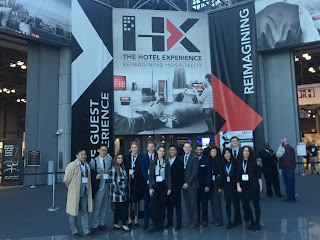Over the Veterans Day weekend, I attended the HX: The Hotel Experience 2018 and the BD | NY: A Boutique Design Trade Fair with a group of students from the Collins College of Hospitality Management at Cal Poly Pomona at the Javits Center in New York City. Also known as the “ihrms Hotel Show,” the HX: The Hotel Experience 2018 is often perceived as the largest hospitality trade show in North America.
What did the HX: The Hotel Experience 2018 entail?
There were four components in the trade show, including HX: The Marketplace, HX: The Conference, Boutique Design New York (#BDNY), and the STR Market Study Competition. Attendees of the HX Marketplace or Conference also had access to BDNY, one strategy that helps trade shows attract more participants.
1. HX: The Marketplace – there were more than 300 exhibitors in this part of the trade show, a place where buyers and sellers met. The exhibition hall also featured three designated areas for 30+ education sections under three areas of HX: Onstage Hotel, HX: Onstage F&B (food & beverage), and HX: Onstage Tech.
2. HX: The Conference – this conference featured one general opening session and 15 breakout sessions that focus on three areas: Future Trends, Technology, and Operational Excellence. There were also over 50 HX: GenFWD education sessions tailoring to hospitality students.
3. #BDNY – this was the marketplace designated for over 750 manufacturers or representatives of the suppliers for boutique-design products in the hospitality industry, such as furniture, lighting, wallpapers, artwork, flooring, bath, spa, and etc. It is expected 8,000 interior designers, architects, hotel owners, hospitality business operators, and purchasing executives will attend this trade show.
4. STR Student Market Study Competition – this competition was hosted and sponsored by STR (Smith Travel Research); it also took place during the “Hotel Show” at the Javits Center. Since its debut in 2015, STR provides the real market data of a destination to the participating programs usually in few months before the competition. Then, the students in the participating programs (usually in a team of three to five students) will analyze the data on their own and present the results of their analysis, along with their recommendations in the competition. The judging panel will decide and announce the winning teams based on their evaluations on the students’ presentations.
The trends revealed at the HX: The Hotel Experience 2018
I found similar trends from the HX: The Hotel Experience 2018 to the ones I observed at the HITEC Houston 2018 and CHRS2017. For example, many products are designed to enhance guest experience and improve the efficiency of operations.
I was also surprisingly pleased to finally meet “Sally – the robot who makes perfect salads” on the exhibition floor. I used Sally as an example of the automatic services emerged in the hospitality industry when the concept debuted in April 2017. I am glad I was able to touch the machine in person and speak to the manufacturing team.
The trends revealed at #BDNY: A Boutique Design Trade Fair
It appeared to me that most products displayed in #BDNY had contemporary designs with bold colors, reflecting the recent lodging trends. First, more roof-top bar concepts/designs were popping up on the exhibition floor than the past. Then, I also noticed more booths were set up by two or more suppliers rather than by a single supplier. For example, a booth that showcased a roof-top garden design could feature six suppliers --- one provided the carpet, another supplier designed the ceiling, and the others set up the rest of the bar.
Another interesting observation – More hotels are charging a destination or resort fee now
I stayed in a boutique hotel in midtown Manhattan during this trip. I was informed by the hotel chain that a $25 per night “destination fee” plus taxes would be added to my account. Such a destination fee, however, also comes with the following benefits:
· $25 daily food and beverage credit that can be used inside the hotel
· $15 daily laundry credit
· Self-guided audio tour at Grand Central (up to two guests)
· Big Bus City Tour Ticket (at a value of about $60 per adult or $50 per child)
According to a friend of mine who is also working in a boutique hotel in Manhattan, it has become more common now for the hotels in the New York City to charge a destination fee --- “One (hotel) started it, and the travelers still paid for it. Then, everybody else followed.” It is not surprising to see hotels are expected to collect a record of $2.93 billions extra revenues in fees this year.
Such an add-on destination or resort fee can definitely push travelers to spend more money inside the hotel. It could turn out to be a good value for those who will actually use the services. For the travelers who need not use those services every day, however, such fees can only contribute additional net profit to the hotel.
Did you attend this year’s HX: The Hotel Experience 2018 and/or the #BDNY? What do you think of this year’s trade show?
In another note, what do you think of the fact that more hotels are charging resort or destination fees? Will more hotels follow?
Note: This discussion is also featured on Multibriefs.com.




Comments
Post a Comment